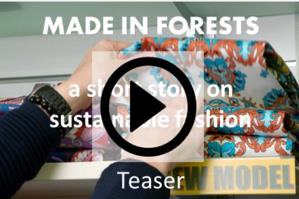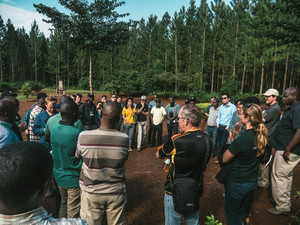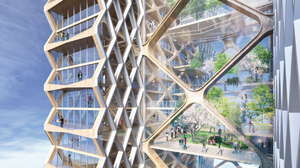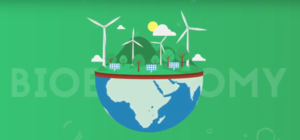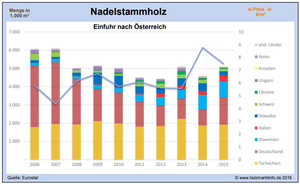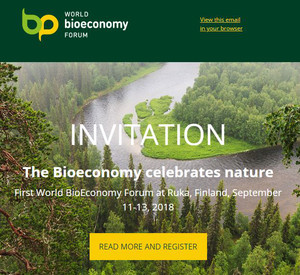Forest Information Billboard
Issue 2, June 2018
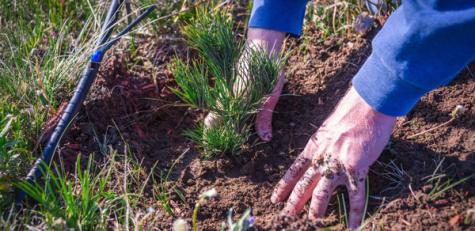
SAVE THE DATE
21-22 June 2018: Ministerial Roundtable - Forest Landscape Restoration and the Bonn Challenge in the Caucasus and Central Asia, Astana, Kazakhstan, https://www.unece.org/index.php?id=47712
17-18 September 2018: Green Forest Jobs - Exploring opportunities and increasing the capacity of UNECE member States, Geneva, Palais des Nations (Room XI), https://www.unece.org/index.php?id=48714
5-9 November 2018: 76th Session of the ECE Committee on Forests and the Forest Industry, Vancouver, Canada, http://www.unece.org/index.php?id=47708
21 March 2019: International Day of Forests - Forests and Education, Geneva, Switzerland, https://www.unece.org/index.php?id=46331
27-29 March 2019: 41st Session of the Joint ECE/FAO Working Party on Forest Statistics, Economics and Management, Geneva, Switzerland, https://www.unece.org/index.php?id=48832
For more details about upcoming events, please refer to the meeting website, the "Events" section at the bottom of the Billboard. All UNECE/FAO meetings are listed here: UNECE/FAO meetings.
Forest reporting
'Made in Forests' - a short story on sustainable fashion
Want to learn more about why fashion is an environmental emergency and how forests can help? Stay tuned. On 16 July at the HLPF2018, UNDP Goodwill Ambassador Michelle Yeoh will launch the video 'Made in Forests', a short story on sustainable fashion.
From 9 to 18 July 2018, the High Level Political Forum (HLPF) on Sustainable Development will meet at the United Nations Headquarters in New York City. Member States, together with other agencies and actors, will affirm political leadership and review global progress towards the achievement of the SDGs.
We want to use this important occasion to highlight the role of forests and forest products in achieving the SDGs. To stimulate the conversation, we will bring the long-standing UNECE/FAO and PEFC collaboration on Forests for Fashion to the Forum.
The 2020 Global and pan-European forest reporting is on!

Forest Resource Assessment (FRA) 2020 Regional Workshop for Europe, the Caucasus and Central Asia took place in UNECE premises in Geneva on 18-20 April 2018. The meeting was organized by the FAO jointly with the UNECE and Forest Europe. Over 30 national correspondents (nominated lead experts in forest reporting) from 29 countries in Europe, the Caucasus and Central Asia attended the event.
The FAO Global Forest Resources Assessment (FRA) is the main source of information on the state of the forests globally. For the first time it is carried out in coordination with the pan-European reporting on sustainable forest management (SFM) as a joint effort of countries in the region supported by the FAO FRA Secretariat, UNECE/FAO Forestry and Timber Section and Forest Europe Liaison Unit Bratislava.
Country reports, prepared by national correspondents will serve as main source of data for both assessment processes. The regional workshop for national correspondents was instrumental as it allowed to provide knowledge to the participants on using reporting tools, familiarize with the reporting content and methodology of both, FRA and Pan European reporting on SFM indicators. The workshop was carried out in the interactive way, to allow national correspondents to discuss any questions and explore any specific issues and challenges that countries face in completing their report. The deadline for the submission of national reports on forest resource assessment in Europe, the Caucasus and Central Asia is the end of October 2018.
Pictures and presentation from the workshop are available at this page: www.unece.org/index.php
Kyrgyzstan advances forest monitoring in support of the Sustainable Development Goals

For the second time under the UNECE/FAO project “Accountability Systems for Sustainable Forest Management in the Caucasus and Central Asia”, Kyrgyz stakeholders met to advance their national criteria and indicator set for sustainable forest monitoring. This exercise is especially important as Kyrgyzstan is currently in the process of adapting a national development strategy which also addresses environmental safety, climate change adaption, ecological sustainability and forests. To monitor progress a forest monitoring system is essential.
Before the UNECE/FAO project was launched in 2016, only a couple of specialists and researchers worked on the criteria and indicators for sustainable forest management in Kyrgyzstan. Today we look at a different picture; the Kyrgyz State Agency on Environment Protection and Forestry was very active in the past year and ran several consultation rounds on the draft criteria and indicator set. The results were now further discussed in a participatory multi-stakeholder workshop held in Bishkek 25-26 April 2018.
PEFC and United Nations are looking for partners to promote Sustainable Fashion
In order to promote the sustainability within the fashion sector, PEFC and United Nations have joined to develop the Forest For Fashion Initiative. Currently, both nonprofit organizations, are looking for partners to provide the necessary co-funding to help this initiative.
The goal is to strength the narrative around sustainable forestry and the positive Sustainable Development Goal (SDG) impacts we can create by using forest-derived products in the fashion sector.
From 9 to 18 July 2018, the High Level Political Forum (HLPF) on Sustainable Development will meet at the United Nations Headquarters in New York City. Member States, together with other agencies and actors, will affirm political leadership and review global progress towards the achievement of the SDGs.
PEFC and United Nations want to use this important occasion to highlight the role of forestry in achieving the SDGs through a fashion exhibition, a cocktail reception which will take place the 16th of July and a video campaign. The exhibition will show some of the creations of Maria Lafuente, Spanish designer who is collaborating with PEFC Spain to promote the sustainable fashion. The garments are made using fabrics from forests manufactured by Textil Santanderina, the largest fabric producer in Spain. PEFC Spain is playing an important role to connect the supply chain to ensure traceability ensuring each step of the manufacturing process is PEFC Chain of Custody certified.
For more information and to get involved, please contact: [email protected] / [email protected]
More information in English: pefc.org/projects/markets/forests-for-fashion-initiative
More information in Spanish: www.pefc.es/moda-sostenible/moda-sostenible.html
How to ensure a sustainable provision of forest Ecosystem Services?

European forests and their active management are essential for fulfilling the Paris Agreement ambitions on climate change mitigation and adaptation, and to foster rural development and green jobs, while ensuring the environmental integrity of a large part of Europe’s terrestrial ecosystems. On the one hand, the provision of many ecosystem services from forests is not always recognized and properly valued. On the other hand, wood provision, which is a predominant source of income for forestry, is often considered as a trade-off for other essential ecosystem services. While synergies are to be sought, and trade-offs to be assessed, there is an urgent need to initiate a debate on how to ensure an effective and sustainable delivery of forest ecosystem services to European citizens, because there are growing expectations from forests, and especially from state forests, due to the multiple benefits forests provide and the evolution of societal needs. In order to kick-off such a debate, a seminar entitled “Value Forestry Values” was held on 27 February 2018 back-to-back with the EUSTAFOR General Assembly. The aim of the seminar was to explore and discuss the basic requirements for establishing coherent policies and managerial opportunities, which can boost innovation and attract investments in the forest and forest-based sector while taking full advantage of the multiple goods and services forests provide. And still Ecosystem Services’ provision was one of the key topics of the recent State Forest Conference 2018 which was held in Sardinia in May 2018.
Picture, presentation and a summary report from the seminar are available at this page: https://www.eustafor.eu/value-forestry-values/
New mobile app tracks bamboo in East Africa

Bamboo is an important crop for many farmers and small to medium enterprises. Bamboo grown in households, shelter beds, farms and micro-plantations – in areas which can cover as little as a few square metres – comprise the majority of raw bamboo material used in local industry across Africa, Asia and Latin America.
Despite this, little is known about the scale or quality of bamboo grown on farms and in households. Existing data focuses mainly on bamboo forests, which are larger and easier to measure, but are also often legally inaccessible and so remain out of reach to farmers and industries. A better understanding of local managed bamboo stocks will enable industries to identify suitable suppliers of bamboo goods, and policy makers to assess the potential for wider sector development.
As part of the Dutch-Sino East Africa Bamboo Development Programme, funded by the Netherlands’ ministry of Foreign Affairs and China’s National Forestry and Grassland Administration, the International Bamboo and Rattan Organisation (INBAR) has developed a mobile app which inventories on-farm bamboo resources across Ethiopia, Kenya, Madagascar, Tanzania and Uganda. The map, which is updated continuously, can be visualised on a specially created web platform, as well as through a mobile app (available through Google Play store as ‘INBAR Bamboo Survey’).
INBAR has already started to train users across four countries in how to use and add data to this app. The application should provide a welcome boost to bamboo industries in the region, and to timber-substitution activities more generally.
More information available at: http://www.inbar.int/bamboomobileapp/
Third annual GLF Investment Case Symposium reveals new research and mechanisms in sustainable finance
The Global Landscapes Forum (GLF) Investment Case Symposium was held at the World Bank in Washington, D.C., on 30 May. Under the theme “Building the Investment Case for Sustainable Landscapes and Restoration,” the Symposium marked the third annual finance-focused GLF, which is the largest science-led, multi-sector platform on landscapes, coordinated by the Center for International Forestry Research (CIFOR) in partnership with UN Environment and the World Bank.
Focused on how to use economic incentives and financial investments to achieve a more sustainable planet and tackle climate change, the 2018 Symposium brought together some 200 invitees and more than 8,000 online viewers from research, policy, development, finance and more. Panels and discussions throughout the day covered a range of topics, from financial mechanisms pushing the field of sustainable finance forward to new research findings on the enormous risks land tenure poses to investors and the growing industry of sustainable fashion.
“Good public policies and significant public funding for infrastructure, research and other public goods are essential for these climate and development goals,” said CIFOR Director General Robert Nasi at the opening of the event. “But to me, and that’s why we’re here today, the greatest opportunity for holding back the rise of the global temperatures lies in undertaking fundamental changes in the way that the private economy does business.”
For news coverage and upcoming GLF events, visit CIFOR Forests News and the Global Landscapes Forum.
OVERVIEW AND ANALYSIS IN THE CONTEXT OF FORESTS AND FOREST PRODUCTS – COMPETITIVE BUSINESS WITH QUALITY
10th International Scientific Conference WoodEMA 2017
MORE WOOD, BETTER MANAGEMENT, INCREASING EFFECTIVENESS: STARTING POINTS AND PERSPECTIVE
Business with forest products is more and more concerned with the sustainable development. International collaboration, agreements, standards, certification and governance have an important role. Sustainable markets are significant. International and national business and stakeholder collaboration has a wide importance taking into consideration competitiveness. Business and private sector has an important role in the sustainable development globally. There are many opportunities in the national and international policies, strategies and stakeholder collaboration in the sustainable development. Green international and national approaches represent collaboration in and towards sustainable development. In:http://www.woodema.org/proceedings/WoodEMA_2017_Proceedings.pdf
Melhor Eucalipto

In Portugal, Eucalyptus globulus is the most utilized species for Pulpwood production and it plays a major role in small landowners’ income. Furthermore, eucalyptus is the base of an industry which contributes up to 1,4% of the Portuguese GDP and for thousands of (in)direct jobs.
Nevertheless, half of the eucalyptus stands owned by non-industrial producers presents poor forest management or inadequate practices. Consequently, even though these stands are generally planted in adequate soil and climatic conditions, their production is often bellow its potential, with increased fire risk and pest exposure. On the other hand, plantations managed by the pulp and paper industry are recognized to be sustainable and more productive in similar conditions.
Considering this, CELPA – Pulp and Paper Association which assembles Portugal’s major paper and pulp production companies, launched ‘Projecto Melhor Eucalipto’, a communication project targeted to forest producers, technicians and contractors, which aims to share best practices in subjects such as forest nutrition, soil preparation, planting or pest control, contributing to make their investments more profitable and environmentally responsible. Since its beginning in 2015, the Project has created a website - http://www.celpa.pt/melhoreucalipto/ - with over 70 thousand views, developed yield and financial simulators, films concerning eucalyptus silviculture, informative spots on local radios and flyers. Also, several local activities were developed with demonstration fields and workshops all over Portugal, reaching thousands of interested landowners, local authorities, technicians and forest contractors. Nowadays, “Melhor Eucalipto” is recognized as a reference to get information about best practices in Portuguese eucalyptus plantations.
Uganda - plantations for Africa's prosperity
Uganda is one of the most fertile places in the world, and its growing economy is fueling demand for forest products.In 1990, approximately 30 per cent of Uganda was covered with forests, but by 2015 this figure had fallen to 10 per cent. The major drivers of this deforestation include a booming population – growing at a rate of 3.2 per cent annually – expanding farmland, unregulated charcoal production and rapid urbanization.
WWF’s New Generation Plantations (NGP) platform believes that existing forestry companies in Africa are likely to be the quickest and lowest-cost way to expand forests. There are significant afforestation and reforestation opportunities on under-utilized land, often next to or on land currently owned or leased by forestry companies.
On this NGP study tour, co-hosted by the New Forests Company and WWF-Uganda, participants from around the world are travelling to the regions of Mityana and Bugiri, to discuss how the plantation forestry industry, civil society and national governments can work together to drive sustainable economic development. Participants hear about, and see for themselves in the field, some innovative solutions adopted by one of Africa’s leading greenfield forestry companies. More information: http://newgenerationplantations.org/en/studytours/13
The sky was the limit: forests and sustainable cities
The theme of the International Day of Forests celebrated on 21 March 2018 was Forests and Sustainable Cities. Forests are indeed key to making cities greener, healthier and happier places to live. Vertical forests, vertical farming, and high-rise wooden skyscrapers: the denser our cities become, the greater the need to address the lack of space available for plants and trees, and to think about innovative ways of integrating natural systems into our urban spaces – where the sky is the only limit. This year, the UNECE/FAO Forestry and Timber Section joined forces with the UNECE Housing and Land Management Unit and the FAO Liaison Office in Geneva to highlight unique ways in which forests “have gone vertical”. Eminent speakers presented their "vertical" solutions to address the lack of space available for plants and trees associated with increasing levels of urbanization. The solutions discussed included vertical forests, vertical farming and vertical high-rise wood constructions. The use of wood in construction will remain an important issue for discussion at this year’s ECE Committee on Forests and the Forest Industry, which will take place in Vancouver from 5 to 9 November 2018.
Global Timber and Wood Products Market Update
US consumption of softwood lumber is likely to reach record-highs by 2030, resulting in export opportunities for sawmills in Europe and Latin America, according to a new study from ForestEdge and Wood Resources International
Higher lumber demand from all end-use sectors in the US in the coming years will result in continued expansion of sawmill capacity in the US South and increased imports from overseas, while Western Canada will reduce its shipments to the US market. For more, see the new report: “Future Suppliers of Softwood Lumber to the US Market – Supply and Demand Outlook 2017-2030”.
Seattle, USA. A newly released study by ForestEdge and Wood Resources International forecasts that US softwood lumber demand will grow at an annual rate of 2.3% through 2030, which will be higher than the reports projection of real GDP. The study’s Base Case demand scenario suggests that US lumber consumption will reach an all-time high by 2030.
A detailed analysis of the future consumption of softwood lumber in each of the five end-use categories (residential housing, repair & remodeling, non-residential construction, material handling and other) reveals that the category “Non-Residential Construction” will grow at the fastest rate and will increase its share of the total softwood lumber usage from just over 11% in 2016 to almost 14% by 2030. Lumber consumed by the residential housing sector, including repair and remodeling, will continue to account for the almost 70% of the end-use market.
Read more at: woodprices.com/information/studies/
BIOVOICES: Connecting bio-based forces for a sustainable world
BIOVOICES is a new three year EU H2020 project, co-ordinated by APRE based in Italy. BIOVOICES will organise more than 80 events across Europe with the aim of improving knowledge, identifying challenges and untimately delivering an action plan to bring about greater use of more sustainable including plant based bio-based products.
The forest-based sector plays a central role within the bioeconomy. The field of forestry is also a major driving force behind innovation and utilisation of naturally derived products and needs to ensure its voice continues to be heard across all sectors and platforms.
BIOVOICES is engaging with all relevant stakeholders within the bioeconomy to identify value chains - particularly newly-emerging chains - and to address the challenges related to increasing the use of all bio-based (including forest/wood) products by citizens and society overall.
To achieve this, BIOVOICES is creating a Mobilisation and Mutual Learning (MML) Platform to promote dialogue and the co-creation of research, inovation, development and political content to promote bio-based engagement between all stakeholders and create wider outreach
Join the platform at the BIOVOICES website to ensure the forestry sector takes its righful place in the on-going dialogue.
BIOVOICES has 13 partners in 10 EU member states with Minerva, co-ordinator of the CommBeBiz project, the UK partner.
For further information: www.biovoices.eu
The annual meeting of the UNECE/FAO Team of Specialists on Forest Communication
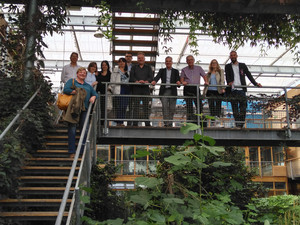
The annual meeting of the UNECE/FAO Team of Specialists on Forest Communication – the Forest Communicators’ Network (FCN) took place 22 - 24 May 2018 in Wageningen, Netherlands. It was kindly hosted by the Ecosystem Services Partnership (ESP).
The objective of the meeting was to exchange on communicating ecosystem services and to find common messages for communication on forestry matters. The meeting was attended by 22 participants from 7 countries and 14 organisations. All presentations held at the meeting are available on the meeting website: http://www.unece.org/index.php?id=48171
CEPF General Assembly 2018 brought together representatives of forest owners from all over Europe
In June, the Europe’s private forest owners gathered in Vienna for the CEPF General Assembly to discuss current forest-related EU policy developments, achievements since previous year and future actions. On behalf of the host, President of the Land & Forst Betriebe Österreich, Felix Montecuccoli welcomed the participants to Vienna.
CEPF gathers 24 members from 19 European countries under its umbrella of family forestry. During the event, the members discussed ongoing EU policy developments such as climate and energy policies and current challenges and prospects of EU strategies, especially the ones on forests and the bioeconomy. The members actively engaged in talks about EU nature policies and gave feedback on the European Commission proposal for the future Common Agricultural Policy post-2020. In the latter one, forestry plays a crucial role as it comes to the rural development and economic opportunities to be provided to the sector. CEPF’s guiding principles, namely sustainable and active forest management, acknowledgement of ownership rights and competitiveness of the forest sector, were reflected in the debates.
During the General Assembly, CEPF President Hubert de Schorlemer highlighted the importance of forest owners’ contribution to the implementation of the United Nations Sustainable Development Goals. Mr de Schorlemer noted that there is an increasing need for enhancing the communication on benefits of the sustainable forest management and on investments made by forests owners to vitality and resilience of forests.
Read more from CEPF website.
Feasibility of implementation of the sustainability criteria for forest bioenergy questioned
Europe’s forest owners and managers recognize the efforts made in the agreement struck during the trilogue talks on the updated EU Renewable Energy Directive (REDII). But to ensure that forests and the forest-based sector continue to contribute positively to the EU’s post-2020 climate and energy targets, care must be taken to ensure that implementation of REDII does not create counterproductive results.
The recast of the Renewable Energy Directive is the first EU Directive which deals with sustainability requirements for forest management. Even though it applies only to bioenergy, the impact of the Directive is much wider as forests are not solely used for bioenergy purposes.
Forest owners and managers welcome the fact that the Directive takes account of existing legislation on forests and forest management in the EU and in Member States. In fact, sustainable forest management has been defined and agreed on by the EU within the framework of the Forest Europe process and its principles have been incorporated into Member States’ forest and nature legislation.
As a next step, forest owners and managers believe that it is crucial that care is taken when developing the guidance rules for demonstrating compliance with the sustainability requirements applied in the risk-based approach, to ensure that the subsidiarity principle and distribution of competences between the EU and its Member States are respected.
Find out more at CEPF Website.
The Forest-based Sector prepares a European Vision for 2040
European Technology Platforms are industry-led stakeholder forums which elaborate strategic research and innovation agendas (SRAs) for action at EU and national level.
In 2005, the Forest-based Sector Technology Platform (FTP) published a bold vision for the first time, focusing on the year 2030. When the vision was renewed in 2012, ten clear and measurable (but non-binding) Vision Targets were added to inspire both public and private decision makers.
It is now time to extend these strengths and build upon current knowledge towards a renewed FTP vision for 2040. The revision process will pool the competence of hundreds of experts throughout the entire forest-based value chain. The new Vision 2040 will be presented on 20 November, in Vienna, during an FTP event organized under the Austrian EU Presidency.
The existing Vision 2030 document can be downloaded from FTP’s website. Meanwhile, please do not hesitate to contact FTP if you want to learn more or become more personally involved in the process. More information.
Paper recycling index reaches record level of 66.2% in 2017, in Brazil, according to IBÁ
The planted tree sector in Brazil has a very positive history with reverse logistics to reduce dry recyclable waste in landfills, with heavy investments in sustainable practices; this impacts the entire production chain, from forests to the finished products that reach the market. In 2017, the recovery rate of paper was a record 66.2%, which is equivalent to 5 million tons that return to the production process. The expansion of this index is in line with efforts within the Brazilian federal government's National Solid Waste Policy (PNRS).
Recycling involves a chain that starts with separation of solid waste individuals, and moves through collection, sorting, and preparation of the collected material, which is then sent to the factory to be transformed into new raw materials. From an economic point of view, this activity reduces production costs, distributes wealth, and promotes the recovery of raw materials, which are reinserted into the consumption cycle. It is important to remember that in order for these materials to reach their proper destination, the entire population must participate.
The planted tree sector in Brazil is one of the most sustainable in the world, and features recycling in the factory as well as in the forest. In Brazil, 100% of paper production (including paper used in packaging) originates from planted trees. These trees are produced in a yearly planting and harvest cycle within a renewable process that avoids deforestation and preserves biodiversity through techniques such mosaic planting, in which trees for industrial purposes are interspersed with native trees.
Publications
Ежегодный обзор рынка лесных товаров, 2016−2017 годы
Ежегодный обзор рынка лесных товаров, 2016–2017 годы, содержит всеобъемлющий анализ положения на рынках в регионе ЕЭК ООН, а также информацию о внешних факторах, влияющих на ситуацию в этом регионе. Он охватывает все этапы производственно-распределительной цепочки, от леса до конечного потребителя, т.е. от производства круглого леса и лесоматериалов первичной обработки до выпуска товаров с добавленной стоимостью и материалов, используемых в жилищном строительстве.
В главах Обзора, основанных на статистических данных, проводится анализ рынков древесного сырья, пиломатериалов хвойных пород, пиломатериалов лиственных пород, листовых древесных материалов, бумаги, картона и целлюлозы. В других главах содержится анализ политики, торговых барьеров, затрагивающих рынки лесных товаров в регионе ЕЭК ООН, а также рынков энергоносителей на базе древесины. В основе этого анализа лежат собранные всеобъемлющие данные. В Обзоре освещается роль устойчивых лесных товаров на международных рынках и обсуждаются политика, затрагивающая сектор лесного хозяйства и лесной промышленности, а также основные движущие силы и тенденции. Кроме того, в нем проводится анализ влияния текущей экономической ситуации на рынки лесных товаров.
To read more please see:
Forest Products Annual Market Review, 2016-2017 in English: http://www.unece.org/forests/fpamr2017
Press Release for Annual Market Review: http://www.unece.org/?id=47053
Wood Energy in the ECE Region
ECE/TIM/SP/42 Wood Energy in the ECE Region highlights the use of wood for energy and includes the most recent statistics on wood energy markets across the UNECE region.
It aims to communicate the relevance of wood energy in the region and help bridge information about the forest and energy sectors.
It also intends to offer some of the best-available information on the role that wood energy can play in various sectors to support environmental, energy, and socio-economic strategies toward a greener economy.
It focuses on commercial wood energy uses in the UNECE inclusive of energy generated for cooking, heating and electricity generation.
Coming Soon: Global Assessment Report on Forest and Water Interactions
The Global Forest Expert Panel (GFEP) on Forests and Water will launch a comprehensive peer-reviewed scientific report and associated policy brief at the 2018 session of the UN High-level Political Forum on Sustainable Development (HLPF) in New York this July. GFEP is an initiative of the Collaborative Partnership on Forests (CPF) led by the International Union of Forest Research Organizations (IUFRO).
The launch of the global assessment report to be published as IUFRO World Series Vol. 38 will take place in the course of a side event titled “Forests and Water on a Changing Planet: Scientific Insights for Building Sustainable and Resilient Societies” hosted by the Permanent Mission of Austria to the United Nations on Tuesday 10 July, 13.15 - 14.30.
The assessment aims to contribute to the 2030 Agenda for Sustainable Development by connecting SDG 6 on water and SDG 15 on forests, thus illustrating the cross-sectoral contributions of forests to the various SDGs. It provides a synthesis of existing scientific information on eco-hydrological processes related to forests, factors influencing these processes, and related ecosystem services. The assessment also highlights the socio-economic roles of forest and water interactions and related challenges, analyses the policy context and identifies response options.Find out more about the GFEP on Forests and Water and keep updated on the launch: https://www.iufro.org/science/gfep/forests-and-water-panel/
70 years working together in the service of forests and people
The ECE Timber Committee and the FAO European Forestry Commission emerged from the International Timber Conference held in 1947 as the key elements of the United Nations tasked with working on matters related to the forest sector in Europe. During their first 70 years of joint activity, the Committee and the Commission have contributed to post war reconstruction, to the expansion of the forest sector, to meeting the major challenges of the sector and to promoting and monitoring sustainable forest management. This paper chronicles the history of the Committee and the Commission’s work, in the context of the 2017 celebrations of the 70th anniversary of ECE and to mark the 70th anniversary of the fruitful cooperation of ECE and FAO on forests in the region. Read more.
Implications of new research for the IPCC 1.5°C special report, with a focus on land use

A new paper from Pivot Point looks at forests’ potential to help battle climate change through ecosystem restoration, reforestation, afforestation, and ‘improved forest management’.
The report Implications of new research for the Intergovernmental Panel on Climate Change (IPCC) 1.5°C Special Report, with a focus on land use ends with recommendations for the IPCC.
These include that they should: continue deeper inquiry into natural climate solutions; provide critical analysis of BioEnergy Carbon Capture and Storage (BECCS); and pay greater attention to both the burden-sharing and inter-generational dimensions of responding to climate risk.
The Bioeconomy revolution must think local
Over the last years, the bioeconomy has been held aloft as the eco-friendly solution for a post-oil society. The buzz around bioeconomy envisages a bio-transformation of the main economic sectors, from construction to transport and fashion, by maximising the potential of emerging digital bio and nanotechnologies. In the future, biomass is transformed into advanced biomaterials, products and services, reducing non-renewable resources to a minimum.
But bioeconomy shouldn’t be taken as a byword for environmental sustainability and one size certainly does not fit all. Producing, collecting and transforming biomass, as well as transporting finished products needs careful consideration as part of a multi-faceted approach. Circular, low carbon and resource efficient developments are needed, that take regional realities into account and seek solutions across sectors.
In southern Europe, current country bioeconomy strategies focus on developing bio-based sectors, especially agriculture, with no clear connection to broader environmental or industrial policies and largely taking sustainability for granted. In these strategies, forests are seen as relevant sources of biomass as well as providing important ecosystem services. Yet they provide little guidance on how to overcome existing barriers and to ensure that increased reliance on forest-based goods and services delivers the expected positive economic, social and environmental impacts.
A new synthesis report coordinated by the European Forest Institute “A forest-based circular bioeconomy for southern Europe: visions, opportunities and challenges” considers the elements required to radically transform production and consumption patterns in this region, with its huge diversity of landscapes and land use.
Read more.
Voices from the forest

Voices from the Forest: Dispatches from the frontline of the fight against illegal logging
At a time when the space for civil society is shrinking, the need for people to be able to influence the powers that control their lives, and have the freedom to work together to tackle the challenges they face, is more critical than ever.
These reports from the frontline of the struggle against deforestation and illegal logging show how it can be done.
Written by local journalists from tropical forested countries which have signed (or are negotiating) Voluntary Partnership Agreement (VPA) timber trade deals with the European Union (EU), these stories offer snapshots of the lives of people dependent on forests for their survival, and underline how putting local people in the driving seat of the policies that affect them is key to keeping forests standing.
With the world’s forests disappearing at alarming rates and new threats to them looming, this report is further evidence of the crucial role forest communities can play in protecting them.
New report assesses bamboo’s contribution to carbon sequestration
A new report published by the International Bamboo and Rattan Organisation (INBAR) analyses bamboo’s effectiveness as a means to store carbon, compared to other types of tree.
Because of their fast growth rates, giant woody bamboos “are already considered effective CO2 absorbers”. Living bamboo stores a similar amount of carbon to tree plantations: from around 100 to 400 tonnes of carbon per hectare (tC/ha). However, this report addresses a gap in previous literature: the impact of ‘displaced’ carbon, or the carbon which is saved by substituting more emissions-intensive products for bamboo. When this is taken into account, “the carbon emissions reduction potential of a managed giant bamboo species forest… can be significantly higher than for a Chinese fir growing under the same conditions.” When bamboo’s potential displacement factor is combined with its fast carbon storage rate, bamboo can sequester somewhere between 200 to 400 tC/ha.
This research is particularly relevant to mechanisms for climate change mitigation. Carbon emissions reduction through product displacement is currently not considered in mechanisms approved under the Paris Agreement for climate change. Bamboo is already used across the world to create a number of durable products, including furniture, flooring, housing, pipes, and renewable energy. A greater recognition of bamboo’s carbon storage potential could see it being used to replace more emissions-intensive fuels and materials including timber, plastics, cement and metals.
The report can be accessed at: http://resource.inbar.int/download/showdownload.php?lang=cn&id=167930
Scientific and Economic Foundations
The Economics of Ecosystems and Biodiversity (TEEB) for Agriculture & Food has released a ‘Scientific and Economic Foundations’ report, which addresses the core theoretical issues and controversies underpinning the evaluation of the nexus between the agri-food sector, biodiversity and ecosystem services and externalities including livelihood and human health impacts from agriculture on a global scale. In particular, the report: (i) argues the need for a 'systems thinking' approach, draws out issues related to health, nutrition, equity and livelihoods, (ii) presents a holistic and universal Framework for evaluation and describes how it can be applied, and (iii) identifies theories and pathways for transformational change.
The report will be of interest to anyone engaged in the general science-policy interface of ‘eco-agri-food systems’, and interested in offering their networks information on a new report that advocates for a holistic, systems-based and inclusive approach to evaluating agriculture and food systems.
Of particular interest to the Forestry/Timber community is the role that agriculture has played in deforestation (and the consequent impacts on biodiversity, ecosystem services, climate and human health), but also its potential for positive impacts on forests, for example through agro-forestry systems. TEEBAgriFood seeks to bring together these considerations into the broader systems analysis of agriculture and food systems.
For quick reading, the report is accompanied by a desktop version (available in hard copy): ‘Measuring what matters in agriculture and food systems: a synthesis of the results and recommendations of TEEB for Agriculture and Food’s Scientific and Economic Foundations report’.
Download reports here: www.teebweb.org/agrifood/scientific-and-economic-foundations-report
Statistical Yearbook to Cover the External Trade of All EU-countries
Now for the third time a statistical yearbook is available which covers the external trade of all EU-countries with regard to their most important wood products, for example, exports or imports of sawnwood from Sweden or imports of logs to Germany: For each particular product there are tables with the amount, the value and the price of the imported or exported product for all 28 EU-countries.
The Excel-tables and graphics (which are also available as pdf files) provide the most important information about the international trade with wood products. Though written in German, everything is relatively international and easy to understand (unless you can’t guess that “Großbritannien” is the German translation of ”Great Britain“.)
More than 800 pages, 800 graphics 2.400 tables. Price: 298.00 € + VAT
Order your copy from: www.holzmarktinfo.de or by e-mail to [email protected]
China’s Import Demand for Softwood Logs & Lumber to 2022
The Changing Supply Chain in China: Focus on Russia’s Industry/Export Potential
Scheduled for release in July 2018, available for purchase NOW!
Details: https://www.woodmarkets.com/publication/china-book/outlook-to-2022/
Sources of Softwood Lumber to the US through 2030
A Collaborative Multi-Client Study by Wood Resources International & ForestEdge LLC
The purpose of this study is to evaluate how US demand for softwood lumber could be met as the supply dynamics of North America change and off-shore supply and production economics evolve over the next decade.
The 200+ page study covers:
I. Demand: Projected Demand for Softwood lumber in the US 2016-2030: This section is based on projections of housing starts (demographics, multi/single family starts, avg ft2 size), R&R expenditures and related softwood lumber consumption, and the evolution of other demand sectors (Non-residential housing - CLT, and other industrial uses).
II. Supply: Projected sources of softwood lumber Supply 2016-2030: This part centers on profiles of key supply regions including NZ, Chile, Brazil, Sweden, E Canada, W Canada, the USPNW and US South. Each will analyze the current supply and use of softwood logs in the region, a projection
of timber supply, an analysis and projection of delivered log costs, an overview of the softwood sawmill industry, lumber production forecasts and delivered lumber production cost model, and an assessment of potential exports to the US market. Mini-profiles will be also provided of Germany, Finland, Latvia, and Western Russia.
III. Supply Curve Analysis: The study will use alternative projections of softwood lumber demand and supply on a delivered cost basis to identify the most likely suppliers to the US market, and discuss how delivered costs and trade may be impacted by changing sources of supply.
IV. Conclusions and Sensitivities: In addition to reporting results for various demand scenarios, the Study will consider sensitivities around exchange rates, and insight into the implications of the changing US softwood lumber situation on timberland investments in selected regions.
Håkan Ekström ([email protected])
Events
Ministerial Roundtable on Forest Landscape Restoration and the Bonn Challenge in the Caucasus and Central Asia
 On 21-22 June 2018, the Ministerial Roundtable on Forest Landscape Restoration and the Bonn Challenge will bring decision makers from the Caucasus and Central Asia together to discuss challenges and identify solutions related to forest landscape restoration in the region.
On 21-22 June 2018, the Ministerial Roundtable on Forest Landscape Restoration and the Bonn Challenge will bring decision makers from the Caucasus and Central Asia together to discuss challenges and identify solutions related to forest landscape restoration in the region.
Led by the Ministry of Agriculture of the Republic of Kazakhstan, in cooperation with UNECE/FAO and IUCN, the two-day meeting in Astana will be instrumental in furthering regional efforts on forest landscape restoration. This Roundtable also bears the first opportunity to align national and regional efforts in the Caucasus and Central Asia with the international Bonn Challenge – a global effort to bring 350 million ha degraded and deforested land into restoration by 2030.
More information about the event can be found at https://www.unece.org/index.php?id=47712.
Forests and Fashion at the High Level Political Forum on Sustainable Development 2018

From 9 to 18 July 2018, the High Level Political Forum (HLPF) on Sustainable Development will meet at the United Nations Headquaters in New York City. Member States, together with other agencies and actors, will affirm political leadership and review global progress towards the achievement of the SDGs.
The theme of this year’s High Level Political Forum (HLPF) on Sustainable Development, which is set to take place from 9 to 18 July 2018, is "Transformation towards sustainable and resilient societies". As much of its programme is set out to do just this, the UNECE/FAO Forestry and Timber Section wants to use this important occasion to highlight the role of forests and forest products in achieving the SDGs.
The long-standing UNECE/FAO and PEFC collaboration on 'Forest for Fashion' has partnered with many other organisations such as UNFF, SFI, and Cittadellarte Fashion B.E.S.T. and many designers to stimulate the conversion through a range of activities and events, such as an exhibition on Forests, Fashion and the SDGs, and the launch of a short movie on sustainable fashion called “Made in Forests”. UNECE is also organizing a side event on 10 July which will explore the possibilities for a UN Partnership on Sustainable Fashion and the SDGs.
25-27 June 2018: Watch this space: The Global Bamboo and Rattan Congress
On 25 to 27 June, the International Bamboo and Rattan Organisation (INBAR) and China’s National Forestry and Grassland Administration will host the world’s first Global Bamboo and Rattan Congress. The Congress, which will take place in Beijing, China, will provide the first platform of its kind to discuss ‘nature-based tools’ for sustainable development and South-South Cooperation.
Bamboo and rattan are strategic plants which can contribute to a number of goals covered in the UN’s Agenda for Sustainable Development. In particular, this Congress will focus on the potential of bamboo and rattan as ‘nature-based tools’ which can combat climate change, restore degraded land, alleviate poverty and reduce stress on forest resources. The Congress is expected to launch a number of important new policies, programmes and partnerships which will have a direct impact on national and regional forestry and development initiatives across the world.
The Congress will be attended by over 1000 participants from across INBAR’s 43 Member states, as well as high-level representatives from governments, development organisations, research institutions and the private sector.
Results from the Congress, including press releases and publicatons, will be published on INBAR’s website: www.inbar.int and on social media using the hashtag #BARC2018.
The Bioeconomy celebrates nature
The First World BioEconomy Forum at Ruka, Finland, September 11-13, 2018
The inaugural World BioEconomy Forum, to be held in the famous Ruka resort, will bring professionals from the leading edge of the bioeconomy face to face with one of the world’s most exquisite areas of outstanding natural beauty.
Public and private sector bioeconomy stakeholders will meet amidst bio-diverse forests and cascading rapids. The event will explore innovative ways of harnessing the unique bio-resources of Europe’s northern region in pursuit of a sustainable and economically meaningful bioeconomy. Many of the lessons from Ruka will be relevant to, and valuable for, other environmentally delicate regions.
Register and view the full programme here.
China’s Global Wood Trade Conference & Tour
MARK YOUR CALENDARS!
China’s Global Wood Trade Conference & Tour
Changing Global Supply Dynamics & Market for China
- September 16-17, 2018
- Chongqing, China
- Click for details
https://www.woodmarkets.com/conference/conferences-china/2018-china-global-wood-trade-conference/
Cool forests at risk?
The critical role of boreal and mountain ecosystems for people, climate, and nature
IBFRA18 - 17-20 September 2018, IIASA, Laxenburg (Vienna), Austria
We are very proud to announce that Her Excellency Elisabeth Köstinger, Federal Minister for Sustainability and Tourism of Austria, joins the Cool Forest Ambassador initiative: “Multifunctional boreal forests and mountain forests are among the ecosystems most affected by climate change. They play a key role in tackling climate change and achieving the Paris climate goals. I am therefore supporting the IBFRA18 Cool Forests Conference and I am delighted to be an Ambassador for Cool Forests.“
The Cool Forests Conference (IBFRA18) promotes the critical role of boreal and mountain ecosystems for people, bioeconomy, and climate. It will bring together and support the dialogue of academia and decision makers from policy, business and civil society. It is initiated by IBFRA, the Pan-Eurasian Experiment (PEEX), and the International Institute for Applied Systems Analysis (IIASA), supported by the International Union of Forest Research Organizations (IUFRO).
This is the start of a collective effort to raise awareness, maintain and promote the multiple values of those ecosystems and create sustainable pathways for this important part of our earth system.
The Cool Forest Ambassadors’ Call for Action supports this effort. It is a wake-up call to the world, to raise awareness of boreal and mountain forest ecosystems for people, bioeconomy, and climate. Sign up here!
For more information about the conference please visit the IBFRA18 website: https://ibfra18.org/ and follow us on Twitter: @ibfra18
Who Will Own the Forest?
 September 25-27, World Forestry Center, Portland, Oregon, U.S.A.
September 25-27, World Forestry Center, Portland, Oregon, U.S.A.
Institutional investors have been allocating part of their portfolios to timberland as they seek diversification, inflation protection, and potentially higher rates of return than the bond or equity markets. The evolving nature of this unique asset class, and its potential for protecting both income and conservation values, is the subject of our annual "Who Will Own the Forest?" conference series.
Speakers present issues pertaining to the economy, forestland valuations, investing overseas, regulatory, tax and lending drivers, and emerging values such as carbon, biomass, and environmental credits. This 2½ day conference offers both networking and educational benefits, including continuing education credits for certified foresters, appraisers, attorneys, and CPAs. Who Will Own the Forest? focuses on institutional timberland investing, both domestically and overseas. Engage with over 40 speakers and 400+ attendees from the investment, timber management, legal, forestry, finance and conservation communities in this 2.5 day program of learning and networking.
For more information: https://www.wwotf.org/
Forests: Interconnecting Sustainable Development Goals to Action

EFI 2018 Scientific Seminar, 27 September in Alghero, Sardinia
Mark your calendar! Come to discuss the need for systemic change to build a sustainable future within the new framework of the Sustainable development goals (SDGs), and how forests, sustainable forestry and forest-based solutions can connect the SDGs to action. Furthermore, we will address how to create a compelling forest narrative as basis for sustainable development in a context of growing urbanization.
Registration will open in May. Further info: https://www.efi.int/membership/ac/2018
Come join us for COFFI2018 in Vancouver!

COFFI2018 - the 76th session of the ECE Committee on Forests and the Forest Industry will be held in Vancouver, Canada, from 5 to 9 November 2018.
Under the title ‘Building the Future with Forests’, the meeting will focus on the transition towards a more sustainable society and a circular and bio-economy, based on the provision of forest products from sustainably managed forests.
This year’s Committee session will bring experts, policy makers, business leaders as well as national delegates together through a variety of panel discussions concentrating primarily on the challenges and opportunities for wood and forest products markets, as well as on forests and the circular and bio-economy.
Participants will also have focused dialogues on the functional and technical aspects of wood, including the challenges and opportunities to make wood a key material for a sustainable future and for a healthy business sector. The meeting will benefit from a diversified audience that will have a chance to discuss and pave the way for policies that champion the use of wood products.
In order to enhance collaboration between the relevant players in the region, the COFFI meeting will share its venue with two other wood-related conferences: the annual Wood Solutions Conference of Wood Works! BC, on Tuesday, 6 November, and the Passive House Canada Conference: Partnering for Transformation, from 7 to 8 November.
The draft programme of COFFI2018, the annotated agenda, all relevant documents for the meeting and information on practical matters are be available at: http://www.unece.org/index.php?id=47708
Biocities Forum: Forests transforming urban living on 14 November 2018 in Barcelona, Spain

The Biocities Forum will facilitate international science-policy-business dialogue on the potential of forests and circular bioeconomy solutions to build sustainable and resilient cities.
The Forum will focus on the following key topics:
- Holistic views on the future of cities and their role in leading sustainable change
- Wood engineering products for building construction and architecture solutions
- Forest-based textiles for sustainable clothing and inspiring fashion
- Connecting cities and regions for a resilient rural-urban interface
The Biocities Forum takes place during the same week as the Smart City Expo World Congress in Barcelona. Synergies between the two events will be explored and efforts will be made to invite relevant participants from Smart City Expo to the Biocities Forum.
More info at www.efi.int/biocities
IX Latin American University Symposium on the Environment (SUIMA)
Palacio de lasConvenciones
November 26, 2018 – November 30, 2018
The Universidad Tecnológica de La Habana "José Antonio Echeverría", Cujae, is pleased to call for the scientific, academic and professional community to the 19th edition of the SCIENTIFIC CONFERENCE ON ENGINEERING AND ARCHITECTURE ( CCIA to be held from November 26th to 30th, 2018. The conference will take place at the Havana International Conference Center, Cuba, within the framework of the activities of our 54th ANNIVERSARY.
Among the conferences, symposia and workshops in session under the Convention, is the X Ibero-American University Symposium on the Environment (X SUIMA).
As previous editions of the Symposium, the tenth SUIMA will be an appropriate framework to initiate or strengthen professional and academic contacts and to establish ways of international cooperation between specialists, institutions, organizations and universities in the area of environment and sustainable development .
For more information about the X Ibero-American University Symposium on the Environment (SUIMA), visit the web site: http://suima.cujae.edu.cu
How to contribute? Deadline to provide contributions to the next issue is 15 September 2018. Please note that the content of the billboard does not necessarily reflect the views of the United Nations. Contributions are published as received and editing is the responsibility of the contributor. More information and the previous issues are available here.
We work in Collaboration with the Global Forest Information Service.


